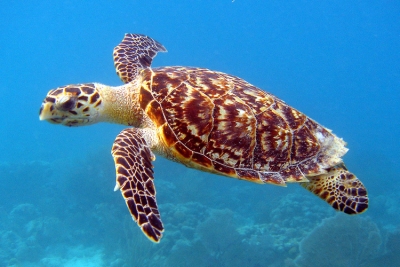WHERE IS THE HAWKSBILL TURTLE FOUND?

The hawksbill gets its name because its mouth resembles the sharp beak of a hawk. The turtle, which has a beautifully coloured and patterned shell, lives among the coral reefs of the Pacific, Indian and Atlantic Oceans. It can grow to about 1.14 m, more than half the length of a full-size bed, and weigh almost 70 kg.
Hawksbill turtles often nest in small numbers, and usually on remote beaches. The largest populations of hawksbills are found in the west Atlantic (Caribbean), Indian, and Indo-Pacific Oceans.
The largest nesting populations of hawksbill turtles occur in Australia and Solomon Islands. Approximately 2,000 hawksbills nest annually on the northwest coast of Australia and 6,000 to 8,000 nest annually in the vicinity of the Great Barrier Reef. The largest rookery for hawksbill turtles in the South Pacific Ocean is in the Arnavon Islands of the Solomon Islands, where approximately 2,000 hawksbill nest each year. Arnavon hawksbills have been heavily exploited for their shell for centuries, but two decades of conservation and monitoring efforts are showing encouraging signs of recovery. Around 2,000 hawksbills nest each year in Indonesia and 1,000 in the Republic of Seychelles.
In the Atlantic, the greatest number of hawksbill nests are laid in Mexico, Cuba, and Barbados, but nesting occurs throughout the Insular Caribbean. The most significant nesting within the United States occurs in Puerto Rico and the U.S. Virgin Islands. Each year, about 500 to 1,000 hawksbill nests are laid on Mona Island, Puerto Rico and another 100 to 150 nests on Buck Island Reef National Monument off St. Croix. In the continental United States, nesting is rare and is restricted primarily to the southeast coast of Florida and the Florida Keys.
In the U.S. Pacific, hawksbills nest primarily in Hawaii where 10 to 25 females nest annually on beaches along the south coast of the island of Hawaii and the east coast of the island of Molokai. This population may constitute one of the smallest hawksbill nesting populations in the world, but is the largest in the Central North Pacific Ocean. In the Eastern Pacific, approximately 700 females nest annually from Mexico to Peru.
Credit : National oceanic and atmospheric administration
Picture Credit : Google